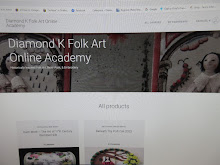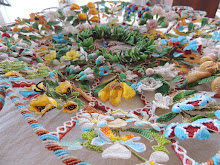 The Museum was really blessed earlier this year with the opportunity to acquire an entire trunk of early clothing, all from a single, Pennsylvania family. I was both amazed and elated that when it arrived, it was a virtual time capsule of mid to late 18th every day common working folks wear~ both ladies & gentlemans, and I am super excited to share it with you all, little by little over the coming winter months :)
The Museum was really blessed earlier this year with the opportunity to acquire an entire trunk of early clothing, all from a single, Pennsylvania family. I was both amazed and elated that when it arrived, it was a virtual time capsule of mid to late 18th every day common working folks wear~ both ladies & gentlemans, and I am super excited to share it with you all, little by little over the coming winter months :)Included in the trunk were several, 5 if I remember correctly, pair of undersleeves. I love undersleeves~ and have several pair, but they all date from the 1820s to 50s, so was a bit puzzled, just at a glance, as to why they were included when everything else was in the 1740-60 era dating. There was so much to go thru, I set them aside and came back to them...and whoa what gems they are indeed!
The above is just one of several pair, but the only ones still connected at their tops. They have been tacked together with linen threads, most likely for washing, as they most definitely have been worn.
 This is yet another pair. All are constructed basically the same, a tube of cloth, gathered both top and bottom~ the top bands wider with tabs for pinning to the bodice sleeves, these of which always numbered in weensie cross stitch numbers. The cuff edge is narrower, with 2 button holes for sleeve links, and these are shaped~ the same shape that bodice sleeves of the period are cut with. The sleeve on the left is showing the back facing up, and the sleeve on the right shows the inner arm up, note the curve to allow for the bent position of the elbow
This is yet another pair. All are constructed basically the same, a tube of cloth, gathered both top and bottom~ the top bands wider with tabs for pinning to the bodice sleeves, these of which always numbered in weensie cross stitch numbers. The cuff edge is narrower, with 2 button holes for sleeve links, and these are shaped~ the same shape that bodice sleeves of the period are cut with. The sleeve on the left is showing the back facing up, and the sleeve on the right shows the inner arm up, note the curve to allow for the bent position of the elbow All measure the same, apx 10" from top to bottom of the elbow cuff
All measure the same, apx 10" from top to bottom of the elbow cuff
All are stitched by hand in fine cotton, which, actually was a sign of wealth this early in the 18th c~ linen was more readily available. The cotton gin had not yet been invented, and cotton was very expensive to produce and procure. This picture shows nicely the cuff shape
 Very finely gathered into the cuff end, with 2 button holes for sleeve links
Very finely gathered into the cuff end, with 2 button holes for sleeve links The top bands are wider, and all are marked in cross stitch with matching numbers~ the ones in this collection are numbered up to 12, so we know Mary Wistar had at least 12 different pair of undersleeves in her wardrobe at one time
The top bands are wider, and all are marked in cross stitch with matching numbers~ the ones in this collection are numbered up to 12, so we know Mary Wistar had at least 12 different pair of undersleeves in her wardrobe at one time I was elated to find on a couple pair, that they still retained their original "sleeve links". Sleeve links were common on mens shirts to fasten the sleeve cuffs, which are two buttons stitched together ~ like the cuff links we think of today that are metal and decorative. These are 2 mother of pearl buttons sewn together with linen thread.
I was elated to find on a couple pair, that they still retained their original "sleeve links". Sleeve links were common on mens shirts to fasten the sleeve cuffs, which are two buttons stitched together ~ like the cuff links we think of today that are metal and decorative. These are 2 mother of pearl buttons sewn together with linen thread.So now you ask, how did dollye help me? Well, you all know I love early wooden dolls, and just so happened to have a photo of a c1750 Queen Anne in the Strong Museum's collection~ and look what she wears there, peeking out under her bodice sleeve....
 click on the picture to enlarge it if you need to~ but yes, as part of her original wardrobe, she too wears a set of these undersleeves. This is a perfect example of why original period dress should always be kept with our early dolls, and also illustrates the fact that these dolls not only taught little ones the correct way and order of dressing, they have indeed helped us today in doing the very same thing
click on the picture to enlarge it if you need to~ but yes, as part of her original wardrobe, she too wears a set of these undersleeves. This is a perfect example of why original period dress should always be kept with our early dolls, and also illustrates the fact that these dolls not only taught little ones the correct way and order of dressing, they have indeed helped us today in doing the very same thing
 click on the picture to enlarge it if you need to~ but yes, as part of her original wardrobe, she too wears a set of these undersleeves. This is a perfect example of why original period dress should always be kept with our early dolls, and also illustrates the fact that these dolls not only taught little ones the correct way and order of dressing, they have indeed helped us today in doing the very same thing
click on the picture to enlarge it if you need to~ but yes, as part of her original wardrobe, she too wears a set of these undersleeves. This is a perfect example of why original period dress should always be kept with our early dolls, and also illustrates the fact that these dolls not only taught little ones the correct way and order of dressing, they have indeed helped us today in doing the very same thing





















No comments:
Post a Comment